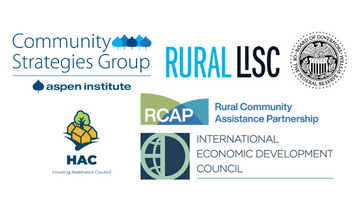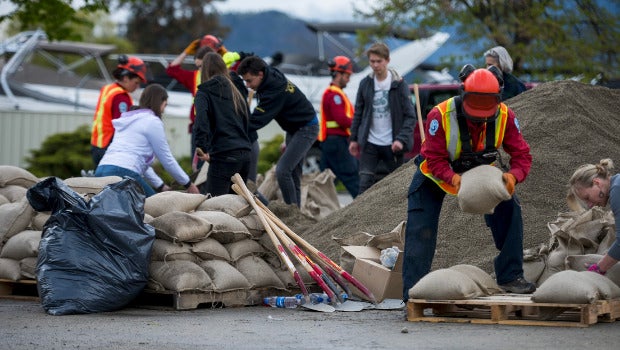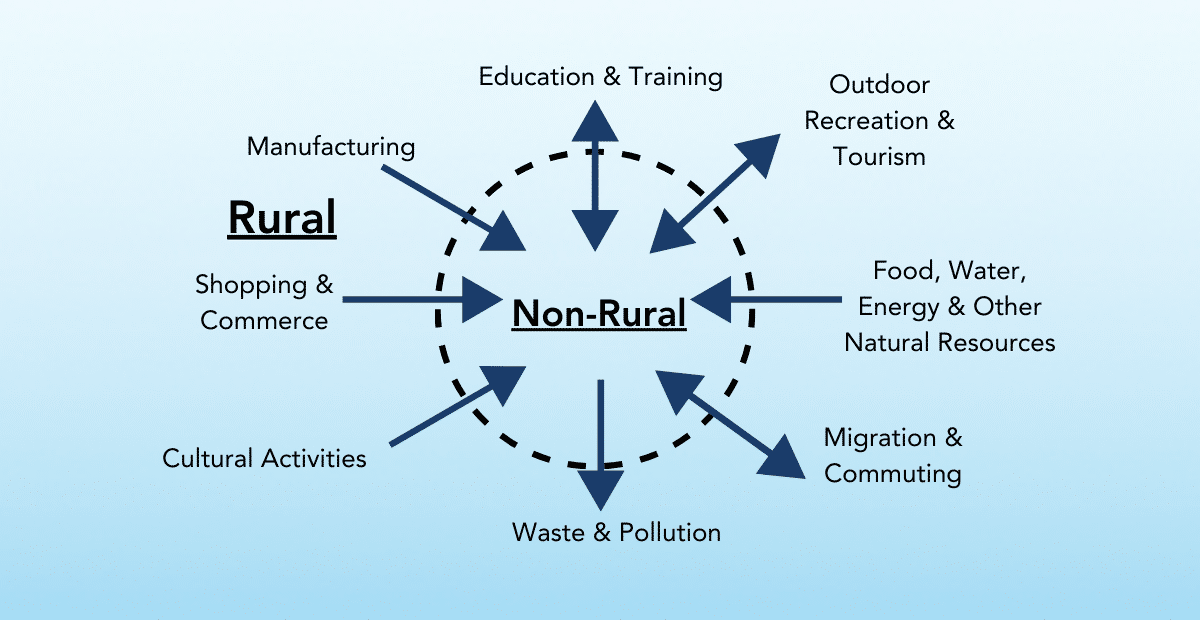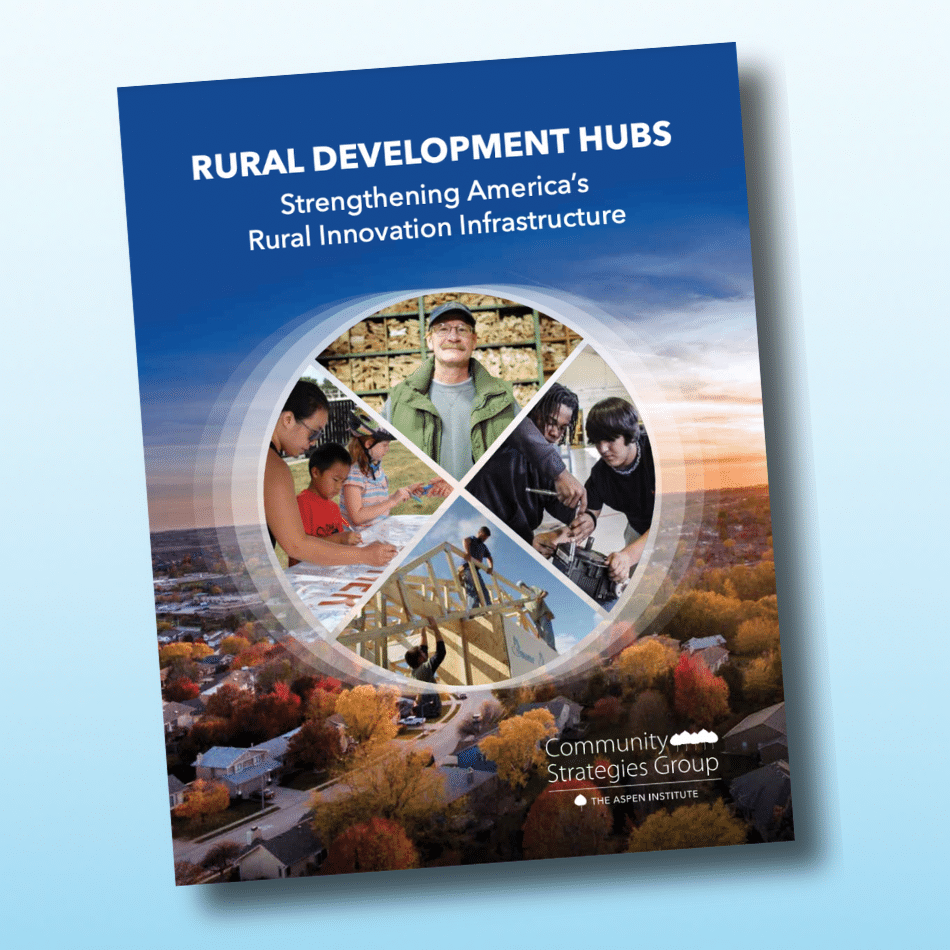On August 1, 2023, the Rural Opportunity and Development Sessions (ROADS) hosted a hybrid in-person and virtual event from the Reservoir Center for Water Solutions in Washington, DC, as part of the larger ROADS series.
The ROADS virtual exchanges are co-designed and hosted by Thrive Rural – an effort of the Aspen Institute Community Strategies Group with support from the Robert Wood Johnson Foundation – in partnership with the Rural Community Assistance Partnership (RCAP), the Housing Assistance Council (HAC), Rural LISC, and the International Economic Development Council (IEDC). The Federal Reserve Board is also a secondary support partner. This event, in particular, was engineered and led by RCAP.
The August event, Rural Disaster Preparedness: Partnering for Resilience & Resources, was attended by over 300 participants from around the nation and included a diverse range of speakers who shared stories and lessons learned from their direct experiences working in rural communities.
The event was moderated by Olga Morales-Pate, CEO of RCAP, and the panelists included Alan Nazzaro, Disaster Recovery Services Program Manager with the Rural Community Assistance Corporation (RCAC), the Western RCAP; Rafaela Monchek, Deputy Administrator of the Office of Disaster Recovery and Resilience with the U.S. Small Business Administration; and Kristyna Jones, K Jones Advisors with the Ironton Reconstruction and Development Committee (IRAD) in the rural community of Ironton, Louisiana.
This two-hour event featured a roundtable discussion by panelists and extended breakout room sessions focusing on the key issues facing rural communities related to disaster preparedness and unique strategies for overcoming these issues based on previous experiences.
This blog gathers resources and big-picture insights shared during the event. You can watch the recording, read the speaker bios, and view the PowerPoint on the event webpage.
Issues Facing Rural Communities
2023 has brought about historic disasters in communities around the county. Record-breaking temperatures, droughts, wildfires, blizzards, flooding, hazardous chemical spills, and an already active hurricane season all highlight the importance and timeliness of this conversation. Rural communities, in particular, face a unique set of challenges when it comes to rural disaster preparedness and recovering from disasters.
The primary issues identified during the event were:
- Limited resources over larger areas: rural communities typically have fewer resources to respond to and recover from disasters when compared to urban areas. Local governments in rural areas often have limited staff capacity and may lack specialized skillsets and the advanced training required for disaster response and recovery. Critical community facilities/infrastructure, such as healthcare, public safety, and transportation, are often already strained under normal conditions due to the larger coverage areas in rural communities and are particularly vulnerable during disasters.
- Financial capacity: federal and state disaster recovery assistance can be slow-moving and generally requires a local match for reimbursement-based programs. This requires significant financial resources to sustain communities while aid is being allocated and to cash-flow communities’ recovery efforts.
- Vulnerable populations: rural communities have higher percentages of residents who are particularly vulnerable during disasters, such as older individuals living alone and individuals with limited mobility. Additionally, many rural residents have deep local roots but may not have an extensive family or social network outside of their home region, limiting their ability to evacuate during a disaster or stay outside the disaster area while recovery efforts are underway.
- Vulnerable industries: Many rural areas rely on agriculture as a key component of the regional economy. Natural disasters can devastate crops, livestock, and equipment and can impact multiple agricultural production cycles. In addition to the direct impact on crops and equipment, disasters can undermine supply chains, which can threaten the long-term viability of an industry in an entire region.
While rural communities face many challenges related to disaster preparedness, they also have significant strengths and opportunities, particularly in the form of social capital and personal connections. Social capital refers to the networks and personal relationships that exist among community members and families. These deep-rooted social networks provide an incredibly valuable foundation for rural communities to build upon to create greater resilience at both the local and regional levels.
Whole Community Approach and Regional Collaboration for Resilience
The ROADS conversation covered numerous scenarios and strategies for overcoming the hurdles listed above, but the foundational strategy for greater rural resilience that was highlighted is a combination of a Whole Community Approach at the local level and greater collaboration between multiple communities at the regional level.
The Federal Emergency Management Agency (FEMA) defines the Whole Community Approach as, “a means by which residents, emergency management practitioners, organizational and community leaders, and government officials can collectively understand and assess the needs of their respective communities and determine the best ways to organize and strengthen their assets, capacities, and interests.”
The two guiding principles of this philosophy are 1.) engaging the entire community in the process of developing disaster preparedness and recovery plans, and 2.) ensuring that all elements of the community have identified roles and responsibilities in those plans. This community-driven approach ensures that individuals and families, businesses, community organizations, nonprofit groups, schools, media, and all levels of government are working collaboratively at the local level both before and after disasters. This holistic and collaborative planning helps communities better withstand disasters and recover more quickly.
While a Whole Community Approach is key at the local level, disasters are regional in their impact, and regional cooperation and collaboration are critical to both disaster preparedness and recovery. Regional coordination between neighboring communities can allow individual governments in rural areas to access resources that they may not have locally. This can happen in the form of regional partnerships that create task forces to coordinate resources during a disaster, information sharing and joint communication systems, standing mutual aid agreements to identify how communities will assist each other during an incident, and many other ways. This regional approach can also be applied to regional industries to make the regional economy more resilient to market shocks by creating industry-wide disaster procedures, business support organizations, and more coordinated supply chains.
The takeaway is that rural communities are truly unique when it comes to their approach to and impact from disasters and that we are stronger together both in rural disaster preparedness and recovery.
Building Back Stronger
Panelist Alan Nazzaro is the Disaster Recovery Services Program Manager with the Rural Community Assistance Corporation (RCAC) and was previously a Group Supervisor with FEMA. Alan shared insights on his experience working with rural and tribal communities in post-disaster recovery and mitigation. In particular, Alan discussed his three years of work in Paradise, CA, which was devastated by the “Camp Fire” in 2018.
Community members in Paradise have been able to utilize federal funding to develop a suite of mitigation projects, programs, and policies that, if implemented fully, can reduce the wildfire risk for the community by up to 80%. The Town of Paradise is an example more vulnerable of how a community can not only recover from a disaster but use the disaster as an opportunity to build the community back stronger.
According to Alan,
“The Town of Paradise had no sewer system whatsoever. A town of 26,000 people were all on septic systems. And now the town is getting grants to do two main lines through the town that will connect them to a plant in Chico California downhill from them.”
The Town of Paradise is using smart growth tactics to concentrate development along the new sewer lines in the interior of town, rather than in peripheral areas that are more vulnerable to wildfire. Additionally, the town is including intermittent parks and open space to serve as buffer zones within the town. These elements will increase the town’s resilience while at the same time improving the overall quality of life for residents.
Community Driven Recovery
Ironton is an unincorporated community in rural Plaquemines Parish, Louisiana, on the west bank of the Mississippi River. Ironton is known as an important site for African-American institution building in Plaquemines Parish and has a long history of social organizing to support equitable community development. In 2021, Hurricane Ida brought devastation to Ironton with 12-14 foot floodwaters that lingered for weeks, making the community inaccessible to residents and destroying every house that had not been elevated following Katrina. Due to a lack of federal and state recovery support, community members coalesced to take charge of their own recovery by creating their own nonprofit, the Ironton Reconstruction and Development Committee (IRAD).
IRAD’s mission statement is to: “pursue community recovery and development based on a deep-rooted, local approach that embraces housing, economic development and health, while recognizing the value of culture, diversity, inclusion, equity, and justice.” Some of IRAD’s strategic priorities include affordable housing development, broadband, street improvements, as well as mitigation efforts like home elevation and levee protection.
Kristyna Jones, a representative from IRAD who joined the panel, highlighted the necessity of a community-driven approach to recovery efforts in small rural communities. Kristyna’s stories from IRAD’s work are an example of how local residents can lead the effort to re-envision the future of their community and be the driver of that future.
New SBA Resources for Disaster Relief
Rafaela Monchek, Deputy Associate Administrator of the Office of Disaster Recovery and Resilience for the Small Business Administration (SBA), closed out the panel discussion with an overview of SBA’s disaster recovery programs.
According to Rafaela, the SBA is “the only federal agency that’s dedicated to small businesses. And our focus is to ignite change and spark action that helps small businesses start, grow, expand, and recover from disasters.”
Rafaela highlighted the new Disaster Assistance for Rural Communities Act that authorizes the SBA to declare a new disaster in a “rural area” upon request by the Governor of a State or the Chief Executive Officer of an Indian Tribal government. This legal change will allow the SBA to more easily provide disaster assistance to businesses and communities, even in the event of a smaller-scale disaster. Additional information on the new law and SBA’s disaster assistance programs is included in the resource links below.
Resource List
The resources, organizations, and programs below were shared by the webinar speakers and by event participants via the chat box. These are not necessarily endorsed by ROADS partners, but we look forward to exploring them with you.
- Aspen Institute Community Strategies Group- Through Natural Disaster to Prosperity: A Call to Action
- This resource identifies five principles to improve health and economic outcomes for rural communities and Native nations — as well as actionable steps to achieve these principles. Aspen CSG convened 39 rural economic and community development practitioners from a diverse range of rural communities and Native nations to inform this resource.
- FEMA Guide- A Whole Community Approach to Emergency Management: Principles, Themes, and Pathways for Action
- A guide that introduces the key concepts of the Whole Community Approach, which empowers all community members to be engaged in Emergency Management.
- FEMA Guide- Guide to Expanding Mitigation: Making the Connection to the Whole Community
- A short handbook focused on connecting communities to resources related to hazard mitigation. The handbook also includes links to other FEMA resources related to community engagement in hazard mitigation.
- Rural Health Information Hub- Rural Emergency Preparedness and Response Toolkit
- The toolkit compiles evidence-based and promising models and resources to support organizations implementing emergency planning, response, and recovery efforts in rural communities across the United States. The toolkit includes six modules as well as case studies from rural communities and organizations.
- USDA Rural Development- Disaster Resiliency and Recovery Resources: A Guide for Rural Communities
- A short guide of available USDA disaster resources for rural communities as well as a summary of federal partner agency roles in disaster recovery.
- EPA Tabletop Exercise Tool for Drinking Water and Wastewater Utilities
- EPA’s tabletop exercise (TTX) tool provides users with the resources to plan, conduct, and evaluate tabletop exercises for drinking water and wastewater utilities. Tabletop exercises practice, test, and help improve emergency response plans and procedures. Use this tool to develop customized, scenario-driven tabletop exercises for your utility.
- RCAP Online Learning- Regionalization and Resilience: Collaboration in Times of Crisis
- A one-hour training module for board members, managers, and other utility leaders of small water and wastewater systems. Technical assistance providers (TAPs) can also use this module to understand how disaster planning, resilience, and regionalization can be part of the broader TMF capacity development work for systems.
- EDA- Economic Development Recovery and Resiliency Playbook
- Produced by the California Association for Local Economic Development in partnership with the U.S. EDA, this guide provides a broad range of strategies and resources for building resilient local economies. The guide is focused on the California context but has information and resources that can be useful to communities nationwide.
- EDA- National Economic Resilience Data Explorer (NERDE)
- In partnership with the EDA, Argonne developed the NERDE to help a variety of users across the country with local economic recovery and resilience analysis. The NERDE consolidates information and data on economic distress criteria, COVID-19 impacts on local economies, and the existence and emergence of industry clusters.
- SBA- New Disaster Assistance for Rural Communities Act
- Brief press release by the SBA with information on the benefits of the new Disaster Assistance for Rural Communities Act.
- SBA- Disaster Assistance Programs
- SBA’s main disaster assistance page with information on the different types of disaster loans that are available, how to prepare for emergencies, and how to apply for disaster assistance.
Next Up: ROAD Session on Placemaking
The next Rural Opportunity and Development Session was on November 2, 2023, and explored concrete placemaking strategies and takeaways relevant to rural communities of every size—even the most isolated and least resourced. Rural-rooted placemakers shared what works without sugarcoating the hard stuff.
About the ROAD Sessions and Organizing Partners

The ROAD Sessions highlight and unpack rural development ideas and strategies that promote access to inclusive economic opportunity and long-term resilience. ROAD Sessions feature stories of on-the-ground practitioners with experience, wisdom, and savvy to share. The series reflects and emphasizes the full diversity of rural America, spotlights rural America’s assets and challenges, and lifts voices and lived experience from a wide range of rural communities and economies. Each Session includes an added opportunity for peer exchange.
Overall, the ROAD Sessions aim to infuse practitioner stories and lessons into rural narratives, policymaking, and practice across the country and to strengthen the network of organizations serving rural communities and regions.
The ROAD Sessions are virtual exchanges co-designed as part of Thrive Rural – an effort of the Aspen Institute Community Strategies Group with support from the Robert Wood Johnson Foundation – and in collaboration with the Housing Assistance Council, the Rural Community Assistance Partnership, Rural LISC, the International Economic Development Council, and the Federal Reserve Board.







